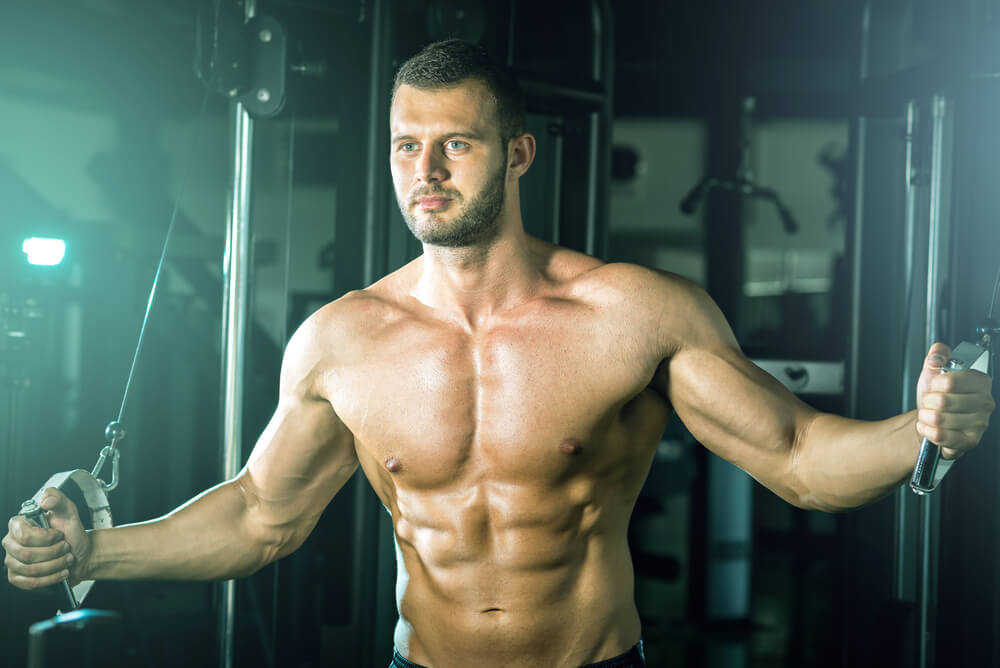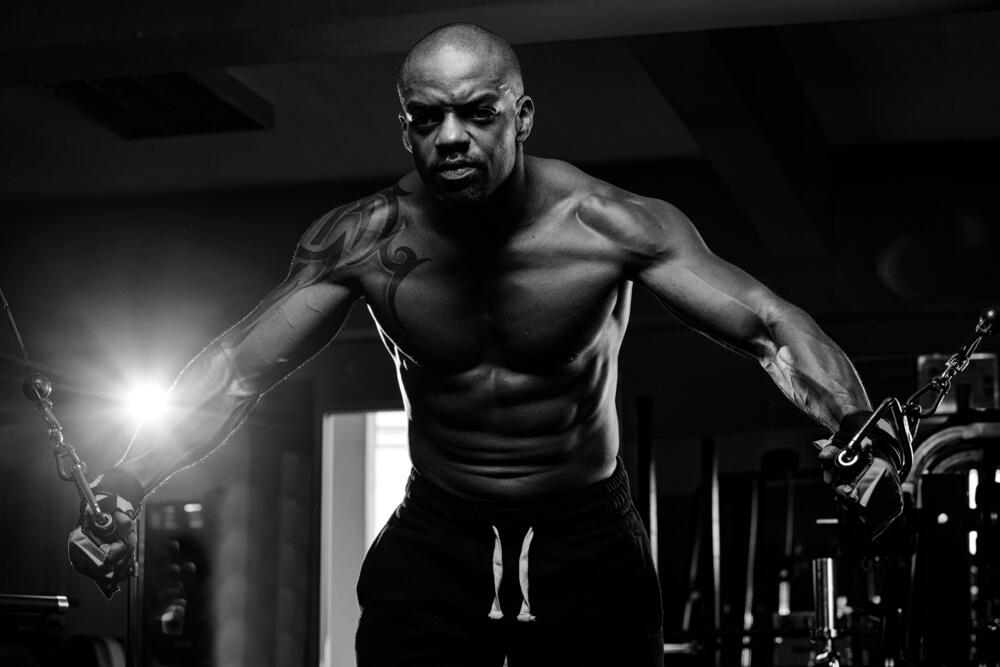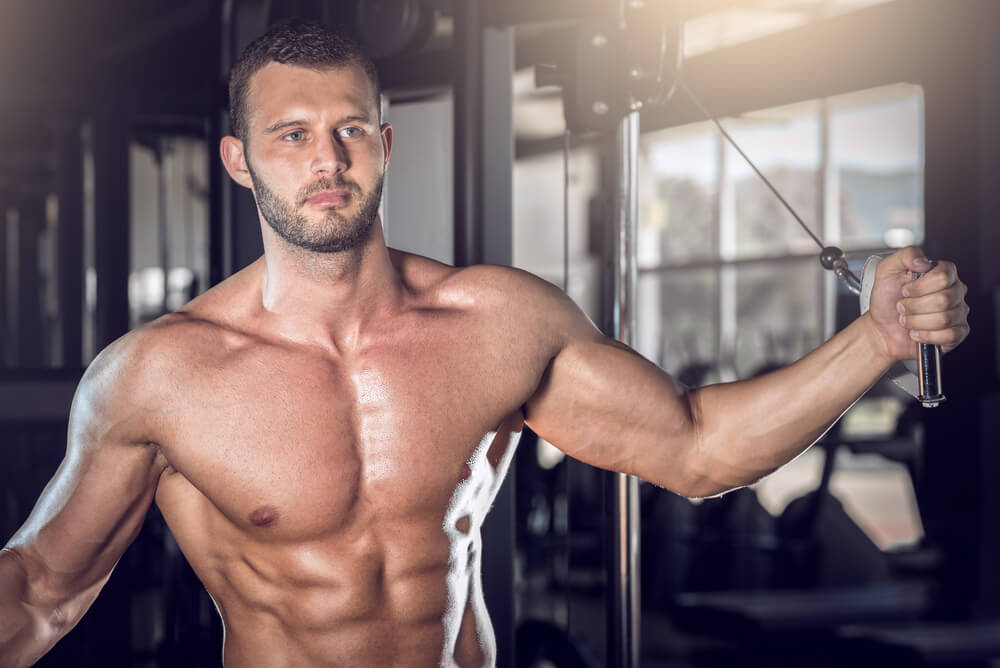
Don’t know how to properly do cable flyes? Wondering where to start? This has all the info you need to know about cable flyes but were afraid to ask. You’re welcome!
Cable flyes are one of the most powerful tools you can use on your best chest workout training days. And, you might be surprised to learn that there are a lot of different types to choose from. That’s right, a lot. Don’t be misled. Many tend to think that all you can do are the standing cable flyes, but you are about to find out that there’s a lot more when it comes to these intense exercises. There’s so many that you could even create an entire chest workout day using the cable machine.
How To Do Cable Flyes
Setting up to do the cable flye exercise is simple. You stand or sit in the middle of two cable pulley machines that have single-hand grips attached.
Standing versions are the most common since nobody really thinks to move the flat bench or exercise chair.
Why?
Who knows?
They may be too lazy to move them. The standing version is when you lean forward and pull both cables in towards your chest muscles in a symmetrical outline.
This type of cable flye targets mainly your low pecs muscles and works greatly when you actually squeeze your pecs into contracting more during the movement. But, your upper pecs are not getting too much of a workout from this. That’s why you should consider working your pecs from different angles. This is the unique feature cables give you that dumbbells and the barbell are not cable of.
Other variations are possible based on the direction you are pulling the cables like up towards your pecs. Then there are variations that come from being in a flat, incline or seated position. Let’s take a look at some good exercises and points before diving into your cable flye bonus workout.
Angle Of Your Motions
As mentioned, the angle of motion results in a lot of diverse outcomes. Coming directly from your sides with the cable flye means regular contraction more on your lower pecs. This, of course, is the spot most chest exercises target. But, if you pull the cables from a lowered position towards overhead you are instead able to get a nice contraction against your upper pecs. In order to do this, you need the cables position to the very bottom setting opposed to your midline.
You could also have your cables set all the way to the top setting and pull the cables in a downward motion. This gives heavy emphasis on your lower pecs, but also activates your upper pecs significantly when you contract to pull the resistance down.
All angles should be used. Simply do so by switching one setting out for another each week. Of course, you could perform all of them in one training session.

Resistance Load For Cable Flyes Is Key
Resistance cable machines are different from free weights. That’s why you usually can’t be using the same load amounts. For example, the 50-pound setting on the cable machine is going to feel pretty light if you are used to doing 50-pound dumbbells for your regular flyes. The concept applies to a lot of things such as the Smith machine. You can lift a lot on it, but when it comes to free weights the resistances do not match.
When trying new resistance cable flye exercises you should start with a lower weight setting such as the second or third selector you can choose.
Why?
Simple, because the different variations may pull on muscles that are tense from not being used much. This could result in a training injury rather quickly. After you feel comfortable, progressively start to increase the load to fit your needs.
Cable machines are not intended for heavy-set movements. You can keep the resistance high, but do not get crazy because the machines can easily break when the weight stacks are dropped or the exercise is done wrong. There really is no need to chase the pump when it comes to resistance cables.
Seated Cable Flyes
The seated version of the cable flye for the most part takes away the use of your legs. People often have a habit of bending at their knees and allowing their legs to assist with the movement.
Another improper thing to do is to use the momentum created by pulling back and lunging your chest forward to help pull the resistance in. This defeats the point of using cable resistance for better contractions.
Seated Incline Flyes
The incline variation really does not target your upper pecs much more than your lower pecs. People seem to think this happens because of the incline being provided, but the incline is not really useful for that.
Instead, it is used for getting your shoulders more involved in the workout as opposed to just your pecs and triceps. Also, the incline helps keep you from arching your back while seated.
Single Arm Flyes
You can actually get any of these cable exercises described into your workout even with only one cable available. This happens a lot during rush hours at the gym. All you have to do is make sure that each side of your body performs the same amount of reps.
One useful benefit of the single arm flye is that it is good for strengthening a weaker pec. Simply use more resistance on the weaker side while the stronger side uses only enough resistance to just stay maintained.
Flat Bench Cable Flyes
Yes, you can actually use the flat bench for this exercise as well. You may even experience better contractions than when you used dumbbells because the resistance causes significant muscle contractions while using the cable machine.
Consider using this variation over dumbbells the next time you want to change up your flat bench exercise.
Cable Crossovers
They do not have the word flyes in the name, but this exercise is essentially a cable flye that has been modified.
When you move the resistance from a high point down you get a nice contraction. But, you can boost the pectoral squeeze by actually crossing the cables over to where you pull them down to opposite sides of your body. This variation is very useful when placed into a well-executed training program.
Cable Flyes On An Exercise Ball
This variation of the cable flye might be the most difficult one. When performed on an exercise ball you need a lot of balance and stability from your core muscles and your legs.
In a sense, this is a full body workout with a cable flye. The catch is that you should seriously consider lowering the resistance on this exercise until you have a better grasp on the feel of the instability caused by the medicine ball. This will not be in the bonus program, but it is something to think about.

Cable Flye Workout
As mentioned, it is best to stick with moderate resistance settings when it comes to cable movements. Doing 8 to 10 reps is far better for your muscle contractions with cables than performing x5 reps with a heavy load setting. Taking a two to three minute rest period between each set to allow your muscles to prime back up for the next set.
The workout should be done using only cables, but this does not mean you perform no compound movements for your pec region. Yes, cable flyes are provided although more pressing movements are needed instead of only variations to the exercise discussed. We added triceps exercises in as well for the cable machine to give you a fully functional workout. You can do these workouts one or two times a week, but do not leave your other muscles behind.
Exercise Sets Reps
Cable Flat Bench Chest Press x5 8-10
Incline Seated Cable Flye x5 8-10
Triceps Rope Pulldown x5 10-12
Low Pulley Cable Flye x5 8-10
Cable Crossover x5 8-10
Triceps Ez-Bar Pulldown Supinated Grip x5 10-12
Relax and Let Your Muscles Grow
Rest and recovery is vital for muscles to function properly and repair themselves after being damaged through resistance training. This is essentially the way it has to be done and nothing will change the fact that protein synthesis must occur. Protein synthesis is when your body takes protein that has been consumed and sends it via your bloodstream to the damaged muscle cells.
Muscle cells contain protein that is either replaced or repaired to allow stronger and denser proteins to take their place. This is why your muscles grow larger over time. Protein synthesis takes 24 to 48 hours to reach completion. That’s why the whole 24-hour rest after training rule came about. Of course, this only applies to the muscle region being targeted. You can easily train your legs following a chest specific training day.
Proper protein intake is the key. You should be consuming 1 to 1.5 grams of protein per pound of body weight when it comes to muscle development. This will ensure you have enough going into the workout and after the workout during recovery. Protein supplements are widely used for this reason since most are incapable of reaching this demand by eating whole foods.
Think about it. While you are resting, your muscles are actually growing since they are going through protein synthesis while taking a break. So what you do in the gym doesn’t really reap you the rewards you want until hours later when you’re doing nothing.

Prevent Shoulder Pains
Shoulder pain is quite common for people that target their chest. Even still, many do not understand that shoulders are involved with pectoral focused exercises almost as much as your triceps are. This excessive use of your shoulders may cause potential harm if you are not giving them a good warm up.
The purpose behind a warm up is to take your joints and tendons through different ranges of motion to basically loosen them up. Tendons easily become tense, especially after a workout. When they get stiff, the muscle can become injured while trying to lengthen and shorten during contractions. The best warm up movement would be the arm circle rotations.
Another aspect to look at would be adjusting the cable machine from high, middle and low. Yes each variation of the cable flye has something more beneficial to offer, but when it comes to chest training you do still target your pecs regardless. If you feel shoulder pain from doing the cable flye or shoulder workouts, on one pulley setting, then consider adjusting to a different position. This may take the pain off of your shoulders.
Conclusion
There you have it! You have all the information on what to do with your cable flyes along with vital training info that will ensure you are ready from start to finish. Make sure to stretch often if your muscles are feeling very tense after training. This will allow them to recover faster than they normally would, as you will be able to continuously keep your body pumping oxygen to your muscles.
Watch out for too much tension being placed on your pecs as well. The way most machines are set up makes you have to roll your shoulders back to grab the handles. Pulling may cause injury if too much resistance is set on the machines. This is another good reason why you definitely do not want to choose heavy load settings for your exercises. Stay safe and continue to train hard.
If you can do that, you should have no problems accomplishing your goals!
By Brian Pankau, CPT
Latest posts by Terry M (see all)
- Garage Gyms - Aug 1, 2018
- Kettlebells – Why They Should Be Added To Your Routine. - Jul 24, 2018
- Weight Belts: What Are They Really For? - May 31, 2018










This article is really informative about cable fly. Just 2 or 3 sets of 8-12 reps should put you nicely where you want to be for flyes, incorporating a different variety into workout routine is also intersting and helpful.
Hey Rebecca,
Thanks for stopping by!
Terry Asher
[…] is then followed by dumbbell flies, which you’ll perform five sets of 10 reps each. Now you do pull-ups if six sets at six reps each […]
[…] case your not familiar with the chest fly, begin by laying on the bench and holding dumbbells in each hand above your chest. Lower your arms […]
[…] your workout program include cable flys? If you want to build your pectoral muscles, this is one of the best exercises you can do for the […]